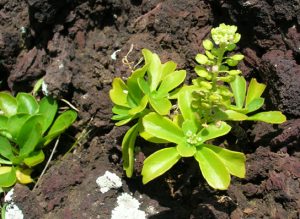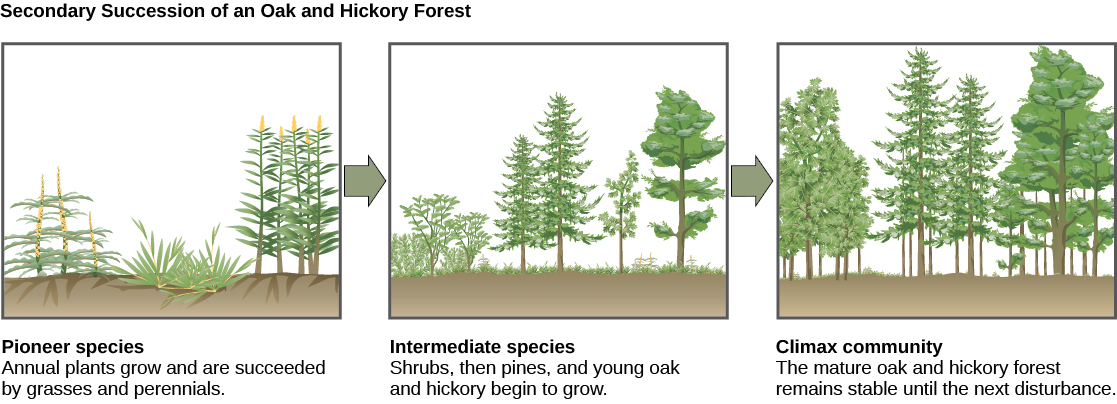17 Chapter 17: Disturbance and Succession
Lisa Limeri
Learning Objectives
By the end of this section, students will be able to…
- Describe primary and secondary succession and the three models of succession: facilitation, inhibition, and tolerance.
- Describe the relationship between disturbance regime (frequency and intensity) and biodiversity in a community.
Ecological Disturbance
Changes in community structure and composition over time are induced by environmental disturbances such as volcanic eruptions, earthquakes, storms, fires, and climate change. Communities with a stable structure are said to be at equilibrium. Following a disturbance, the community may or may not return to the equilibrium state. In primary succession, newly exposed or newly formed land is colonized by living things; in secondary succession, part of an ecosystem is disturbed and remnants of the previous community remain. Thus, disturbance can initiate successional change.
Species that are well adapted for exploiting disturbance sites are referred to as pioneers or early successional species. In forests, these shade-intolerant species are able to photosynthesize at high rates and as a result grow quickly. Their fast growth is usually balanced by short life spans. Furthermore, although these species often dominate immediately following a disturbance, they are unable to compete with shade-tolerant species later on and are replaced by these species through succession. However these shifts may not reflect the progressive entry to the community of the taller long-lived forms, but instead, the gradual emergence and dominance of species that may have been present, but inconspicuous directly after the disturbance. Disturbances have also been shown to be important facilitators of non-native plant invasions.
While plants must deal directly with disturbances because of their lack of mobility, many animals are mobile and thus are not as immediately affected by disturbance. For example, some animals could successfully evade the initial destruction of a forest fire, but can later return to the burned area and thrive on new growth on the forest floor. Disturbed communities (such as a forest after a fire) often support a wider variety of plants compared to pre-disturbance vegetation. The plants in turn support a variety of wildlife, temporarily increasing biological diversity in the forest.
Reading Question #1
Which of the following terms describes the first species to colonize newly-formed land, such as the result of a volcanic eruption?
A. Climax community
B. Keystone species
C. Foundation species
D. Pioneer species
Intermediate Disturbance Hypothesis
The intermediate disturbance hypothesis (IDH) suggests that local species diversity is maximized when ecological disturbances are neither too rare nor too frequent (Figure 17.1). At low levels of disturbance, more competitive organisms will push subordinate species to extinction and dominate the ecosystem. At high levels of disturbance, due to frequent forest fires or human impacts like deforestation, all species are at risk of going extinct. According to IDH, at intermediate levels of disturbance, diversity is thus maximized because species that thrive at both early and late successional stages can coexist. IDH is a non-equilibrium model used to describe the relationship between disturbance and species diversity.

IDH is based on the following premises:
- ecological disturbances have major effects on species richness (the total number of different species) within the area of disturbance,
- interspecific competition results in one species driving a competitor to extinction and becoming dominant in the ecosystem, and
- moderate ecological scale disturbances prevent interspecific competition.
Disturbances act to disrupt stable ecosystems and clear species’ habitat. As a result, disturbances lead to species movement into the newly cleared area (secondary succession). Once an area is cleared there is a progressive increase in species richness and competition between species takes place. Once the conditions that create a disturbance are gone, and competition between species in the formerly disturbed area increases, species richness decreases as competitive exclusion increases.
Reading Question #2
When will biodiversity be highest?
A. Where there is no disturbance in the ecosystem
B. When there is an intermediate level of disturbance in the ecosystem
C. When there is a high level of disturbance in the ecosystem
D. When there are variable levels of disturbance in the ecosystem
Ecological Succession
Communities with a stable structure are said to be at equilibrium. Following a disturbance, the community may or may not return to the equilibrium state. Succession describes the sequential appearance and disappearance of species in a community over time following disturbance. There are two types of ecological succession: primary and secondary. In primary succession, newly exposed or newly formed land is colonized by living things; in secondary succession, part of an ecosystem is disturbed and remnants of the previous community remain.
Primary Succession
Primary succession occurs when new land is formed or rock is exposed: for example, following the eruption of volcanoes, such as those on the Big Island of Hawaii. As lava flows into the ocean, new land is continually being formed. On the Big Island, approximately 32 acres of land are added each year. First, weathering and other natural forces break down the substrate enough for the establishment of pioneer species such as hearty plants and lichens with few soil requirements (Figure 17.2). These species help to further break down the mineral-rich lava into the soil where other, less hardy species will grow and eventually replace the pioneer species. In addition, as these early species grow and die, they add to an ever-growing layer of decomposing organic material and contribute to soil formation. Over time the area will reach an equilibrium state, with a set of organisms quite different from the pioneer species.

Secondary succession
A classic example of secondary succession occurs in oak and hickory forests cleared by wildfire (Figure 17.3). Wildfires will burn most vegetation and kill those animals unable to flee the area. Their nutrients, however, are returned to the ground in the form of ash. Thus, even when areas are devoid of life due to severe fires, the area will soon be ready for new life to take hold.
Before the fire, the vegetation was dominated by tall trees with access to the major plant energy resource: sunlight. Their height gave them access to sunlight while also shading the ground and other low-lying species. After the fire, though, these trees are no longer dominant. Thus, the first plants to grow back are usually annual plants followed within a few years by quickly growing and spreading grasses and other pioneer species. Due to, at least in part, changes in the environment brought on by the growth of the grasses and other species, over many years, shrubs will emerge along with small pine, oak, and hickory trees. These organisms are called intermediate species. Eventually, over 150 years, the forest will reach its equilibrium point where species composition is no longer changing and resembles the community before the fire. This equilibrium state is referred to as the climax community, which will remain stable until the next disturbance.

Climatic factors may be very important, but on a much longer time-scale than any other. Changes in temperature and rainfall patterns will promote changes in communities. As the climate warmed at the end of each ice age, great successional changes took place. The tundra vegetation and bare glacial till deposits underwent succession to mixed deciduous forest. The greenhouse effect resulting in increase in temperature is likely to bring profound Allogenic changes in the next century. Geological and climatic catastrophes such as volcanic eruptions, earthquakes, avalanches, meteors, floods, fires, and high wind also bring allogenic changes.
In general, communities in early succession will be dominated by fast-growing, well-dispersed species (opportunist, fugitive, or r-selected life histories). As succession proceeds, these species will tend to be replaced by more competitive (K-selected) species. Trends in ecosystem and community properties in succession have been suggested, but few appear to be general. For example, species diversity almost necessarily increases during early succession as new species arrive, but may decline in later succession as competition eliminates opportunistic species and leads to dominance by locally superior competitors.
Reading Question #3
What is the difference between primary and secondary succession?
A. Primary succession always occurs before secondary succession
B. Primary succession occurs more often than secondary succession
C. In primary succession a brand new community is founded whereas in secondary succession the community is influenced by the pre-existing community
D. In primary succession, only pioneer species can establish whereas in secondary succession only climax species can establish.
Climax Communities
Ecological succession was formerly seen as having a stable end-stage called the climax community, shaped primarily by the local climate (Figure 17.4). This idea has been largely abandoned by modern ecologists in favor of non-equilibrium ideas of ecosystem dynamics. Most natural ecosystems experience disturbance at a rate that makes a “climax” community unattainable. Climate change often occurs at a rate and frequency sufficient to prevent arrival at a climax state. Additions to available species pools through range expansions and introductions can also continually reshape communities.

Models of Successional Change
Joseph Connell and Ralph Slatyer further developed the understanding of successional mechanisms in their 1977 paper and proposed that there were 3 main modes of successional development: Facilitation, Tolerance, and Inhibition.
Facilitation model
The facilitation model is based on the assumption that only particular species with qualities ideal for “early succession” can colonize the newly exposed landforms after an ecological disturbance.
- These “colonizing” qualities include: highly effective methods of dispersal, the ability to remain dormant for long periods of time, and a rapid growth rate. However, the pioneer species are often subsequently less successful once an area has been heavily populated by surrounding species due to increased shade, litter or concentrated roots in the soil, etc.
- Thus, the presence of early successional species often changes the environment so that the habitat is less hospitable for the original species’ own ecological demands and facilitates the invasion of later-successional species.
The facilitation model suggests that the presence of an initial species aids and increases the probability of the growth of a second species (Fig 17.5). For example, the presence of alder plants aids the growth of willow and poplar seedlings in an Alaskan floodplain. Alder roots contain nitrogen-fixing bacteria, which greatly increase the amount of inorganic nitrogen present in soils. This increased availability of nitrogen aids the growth of both willow and poplar seedlings in areas without other competition. Eventually, however, willow and poplar grow more rapidly than alder, leading to a reduction in the abundance of the pioneer species, and eventually, spruce becomes a later-succession species, due to its increased ability (over alder) to grow in shaded areas.
Another case of facilitation comes from the colonization of lakeshore sand dunes. Adjacent pioneer plants colonize the otherwise moving sands and alter the environmental constraints of the sandy environment to better suit other plant species, which can then allow for soil binding to take place. The giant saguaro cactus, in this respect, can only survive in the shade of other plants (or in some cases rocks) – pioneer species facilitate their existence by providing shade. (The argument has also been made that this type of interaction is exemplary of the tolerance model; see below).

Tolerance model
In the tolerance model, new pioneer species neither inhibit nor facilitate the growth and success of other species. The sequences of succession are thus entirely dependent on life-history characteristics such as the specific amount of energy a species allocates to growth.
- The climax community is composed of the most “tolerant” species that can co-exist with other species in a more densely populated area. Eventually, dominant species replace or reduce pioneer species abundance through competition.
The tolerance model is completely dependent upon life history characteristics. Each species has an equally likely chance to establish itself in the early stages of succession and their establishment results in no environmental changes or impacts on other species (Fig 17.6). Eventually, early species, typically dominated by r-selected species, which prioritize fast rates of reproduction, are out-competed by K-selected species (species that become more dominant when there is competition for limited resources).
For example, we can examine succession in the Loess Plateau in China, where there is initial dominance of the Artemisia scoparia, the pioneer species. Over time, however, the Bothriochloa ischaemum becomes the dominant species and the abundance of A. scoparia greatly declines. This is due to the rapid rate of reproduction of the A. scoparia, resulting in the species’ early abundance, and the dominant competition from the K-selected B. ischaemum, resulting in that species’ later abundance.
A characteristic that is often associated with the tolerance model and well documented in forest succession is survival in conditions of shade. As an uninhabited area becomes populated by different plant species, shade increases – which makes less light available for the next generation. Species that are better adapted to shady conditions will then become dominant.

Reading Question #4
In the tolerance model …
A. Earlier species make the environment more hospitable for other species
B. Earlier species make the environment more difficult for other species
C. Early species completely prevent other species from establishing
D. Earlier species do not directly affect the success of later species
Inhibition model
In the inhibition model earlier successional species inhibit growth of later successional species and reduce growth of colonizing species already present.
- Pioneer species might modify the environment through rapid growth and make the area increasingly shady (essentially increasing competition for light).
- The environment is thus less hospitable to other potential colonizing species.
- The only possibility for new growth/colonization in this successional sequence arises when a disturbance leads to dominating species being destroyed, damaged, or removed. This frees up resources and allows for the invasion of other species that were not previously present
In this model, one species inhibits the presence of another, either through direct means, such as predation (by eating the other species or attacking them), or indirect means, such as competition for resources.
Sometimes in inhibition models, the time of establishment of a species determines which species becomes dominant (Fig 17.7). This phenomenon is referred to as the priority effect and suggests that the species that became established earlier are more likely to become the dominant species. One example of the inhibition model, and the priority effect, occurs in South Australia. In areas where bryozoans are established first, tunicates and sponges cannot grow.
The inhibition model has also been observed at work in forest ecosystems; in these systems the early arrivers hold a monopoly on the land, keeping other species out. Closed shrub canopies have been known to prevent tree growth and access to land for periods of up to 45 years – in an experimental study on inhibition it was found that areas occupied by large areas of Lantana sprawling shrubs excluded and inhibited the growth of tree species.

Reading Question #5
In the inhibition model, which species is most likely to become dominant?
A. The species that arrives first
B. The species that is the strongest competitor
C. The species that is the most shade-tolerant
D. The species that can survive with the fewest resources
References
Adapted from
Clark, M.A., Douglas, M., and Choi, J. (2018). Biology 2e. OpenStax. Retrieved from https://openstax.org/books/biology-2e/pages/1-introduction
and
Holmberg, T.J. (2022) BIOL 1213. LibreTexts. Retrieved from https://bio.libretexts.org/Sandboxes/tholmberg_at_nwcc.edu/BIOL_1213
change in the environment caused by natural disasters or human activities
also known as early successional species, these are the first species to appear in primary and secondary succession
also known as pioneer species, these are the first species to appear in primary and secondary succession
a hypothesis proposing that maximal species diversity occurs when when environmental disturbance are at an intermediate scale (moderate frequency)
the process by which species in a given area change over time
also known as probiosis, the facilitation model proposes that one species can benefit another species' fitness, and neither species is harmed
this model, in contrast to the facilitation model, proposes that pioneer species do not change abiotic or environmental conditions in a way that affects the invasion of other species
in contrast to the facilitation and tolerance model, this model proposes that early species make it harder for later successional species to inhabit the site and also decrease the growth of other existing species

